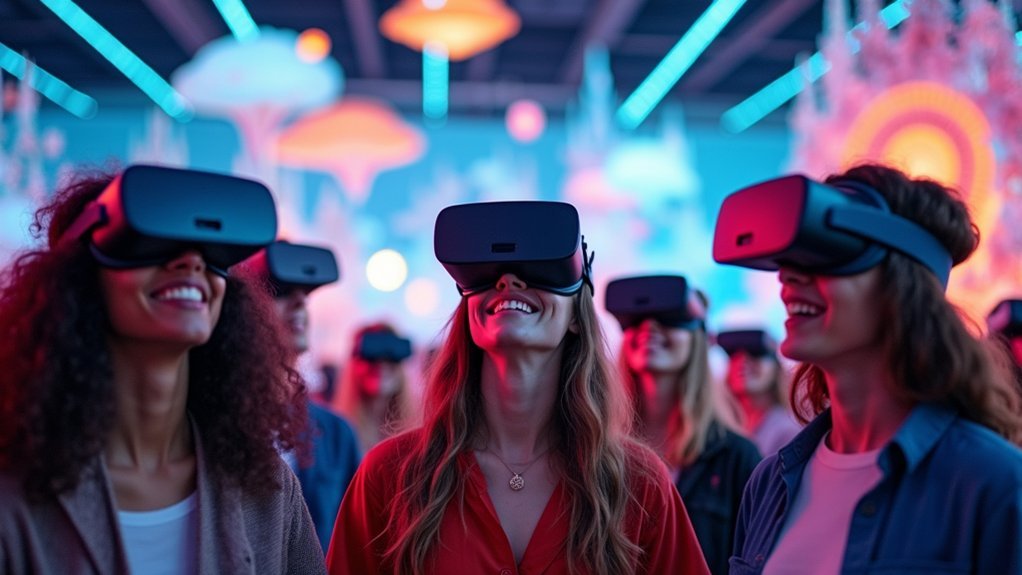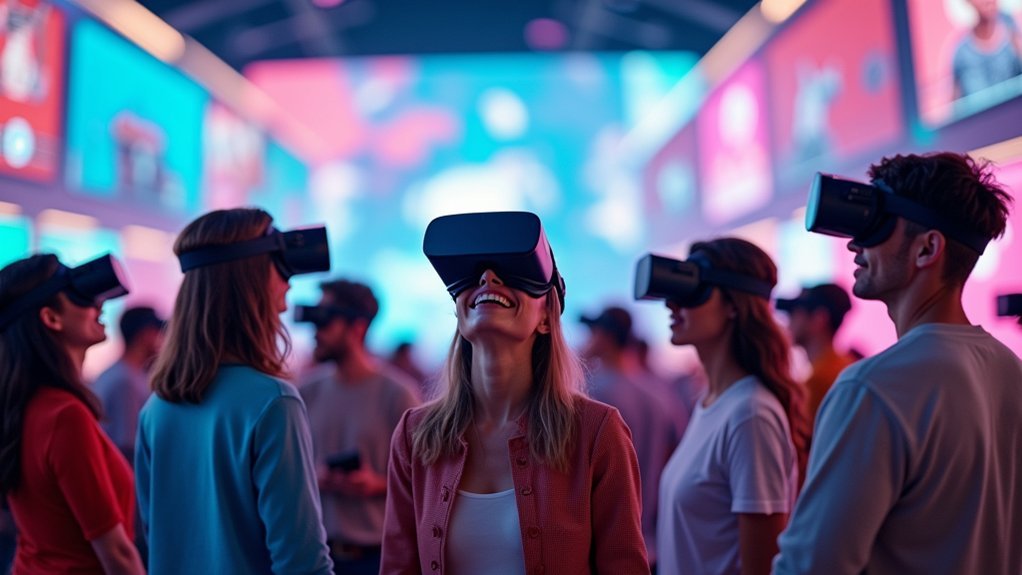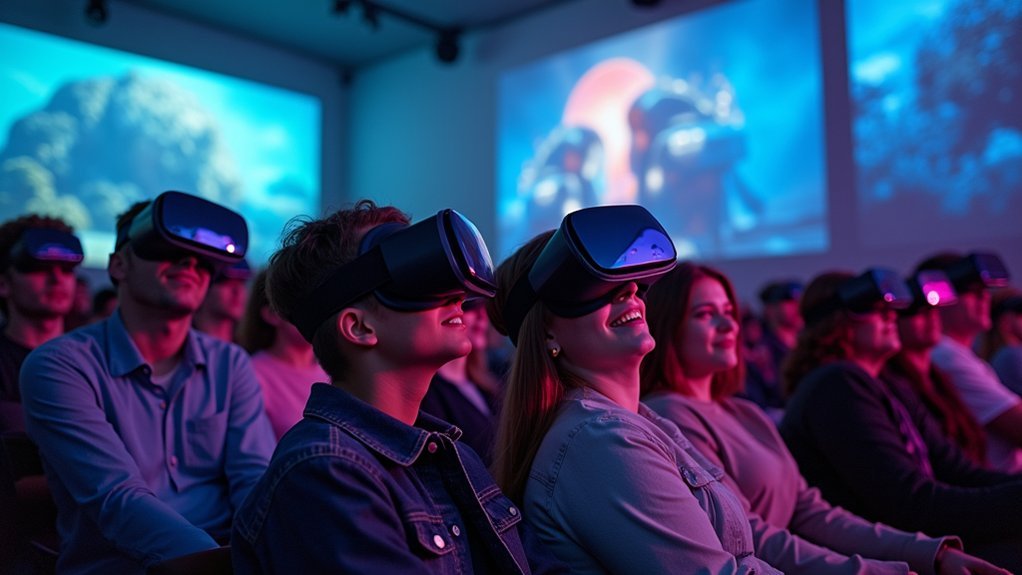You’re witnessing Oculus Rift’s content universe reshape entire industries beyond gaming, from healthcare training that delivers 75% higher knowledge retention to social VR platforms fostering authentic connections. The platform’s sophisticated developer tools and cross-platform compatibility have created a $31 billion ecosystem where exclusive titles like “Half-Life: Alyx” coexist with professional medical simulations and immersive corporate training. Rift’s influence drives competitor innovation while its rigorous content curation guarantees quality experiences that’ll define VR’s expanding future applications.
The Foundation of Modern VR Content Development

When Oculus Rift launched in 2016, it didn’t just introduce another gaming peripheral—it ignited a creative revolution that transformed how developers approach virtual reality content.
You’re witnessing the birth of an entirely new medium where traditional gaming boundaries dissolved.
The platform’s sophisticated tracking systems and high-resolution displays gave developers tools they’d never had before.
You can see this impact in how creators began designing specifically for immersive experiences rather than adapting existing formats.
The Oculus Touch controllers particularly changed everything—suddenly, you could interact naturally with virtual worlds using hand movements.
This technological foundation sparked unprecedented innovation.
Developers weren’t just making games anymore; they were crafting entirely new forms of interactive entertainment that leveraged VR’s unique capabilities.
Exclusive Gaming Experiences That Define the Platform
The exclusive games that emerged from this creative foundation didn’t just showcase VR’s potential—they redefined what interactive entertainment could become.
You’ll find “Half-Life: Alyx” delivering deep storytelling through immersive gameplay that’s impossible on traditional platforms.
“Beat Saber” transforms your entire body into a controller, creating rhythm-based experiences that highlight the intuitive Oculus Touch controllers.
When you explore “Moss,” you’re witnessing innovative storytelling methods that blend puzzle-solving with charming narrative worlds.
“The Walking Dead: Saints & Sinners” demonstrates how VR experience can integrate complex resource management with survival horror elements.
These exclusive games don’t simply adapt existing formats—they create entirely new interactive possibilities that attract gamers seeking experiences unavailable elsewhere, strengthening Oculus Rift’s competitive position.
Cross-Platform Compatibility and Content Sharing

Beyond these platform-defining exclusives, Oculus Rift’s true strength emerges through its remarkable cross-platform compatibility that breaks down traditional VR boundaries.
You’ll discover that Oculus Link transforms your experience by granting access to SteamVR’s vast library, effectively doubling your gaming options. This cross-platform compatibility guarantees you’re never limited to a single ecosystem.
The content sharing capabilities within Oculus Home create unprecedented opportunities:
- Access cross-buy titles that work across multiple Oculus devices
- Share custom experiences and creations with the community
- Play games from various VR platforms through seamless integration
- Collaborate with developers creating cross-platform experiences
- Expand your content library beyond native Oculus offerings
You’re witnessing Oculus’ commitment to fostering innovation through developer support, guaranteeing the platform’s longevity in VR’s rapidly evolving landscape.
Developer Tools and Creation Framework Impact
You’ll find that Oculus Rift’s developer tools transform how you create VR content, with Unity integration streamlining your workflow from concept to deployment.
The SDK’s accessibility features let you build inclusive experiences that reach diverse audiences without complex workarounds.
Cross-platform development support means you can deploy your creations across multiple VR ecosystems, maximizing your content’s reach and impact.
Unity Integration Benefits
Five key advantages emerge when developers harness Unity’s integration with Oculus Rift, fundamentally transforming how VR content gets created and deployed.
- Streamlined Development Access – You’ll gain direct access to Oculus SDKs and APIs through Unity’s built-in support, eliminating complex integration hurdles.
- Rapid Prototyping Capabilities – You can iterate quickly and reduce development costs while maintaining high-quality visuals and VR-optimized interactions.
- Comprehensive Asset Library – You’ll leverage pre-built templates and assets for spatial audio, physics, and VR-specific UI elements designed for Oculus Rift.
- Cross-Platform Deployment – You can easily port your content across multiple VR devices, expanding your market reach beyond single-platform limitations.
- Community-Driven Innovation – You’ll tap into Unity’s collaborative ecosystem of forums, documentation, and shared knowledge from fellow VR developers.
SDK Accessibility Features
While Unity integration streamlines development workflows, the Oculus SDK’s accessibility features fundamentally reshape how you approach inclusive VR design.
You’ll find customizable control schemes that adapt to different physical abilities, ensuring your content reaches users who might otherwise be excluded from virtual experiences. The SDK provides visual aids and alternative interaction methods that expand your potential audience considerably.
When you implement these accessibility tools, you’re not just adding features—you’re creating pathways for diverse users to engage with your VR content.
The framework’s built-in support for assistive technologies means you can design experiences that accommodate various disabilities without extensive additional coding. This thorough approach to accessibility transforms VR from exclusive technology into an inclusive platform that welcomes all users.
Cross-Platform Development Support
Because modern VR development demands flexibility across multiple platforms, Oculus Rift’s cross-platform development support transforms how you approach content creation.
The Oculus SDK enables you to build applications that run seamlessly across different VR systems, eliminating platform-specific limitations.
You’ll benefit from these cross-platform development advantages:
- Unity and Unreal Engine integration that creates highly optimized VR content with advanced graphics
- OpenXR standard support that guarantees compatibility with various VR hardware and software
- Broader audience reach without being restricted to specific devices
- Streamlined workflows through the Oculus Developer Hub for testing and debugging
- Collaborative community resources that foster knowledge sharing and innovation
This thorough approach means you can focus on creating immersive experiences rather than worrying about technical compatibility barriers.
Educational and Training Applications Ecosystem
You’ll find that Oculus Rift has transformed how professionals acquire critical skills through immersive medical training simulations that let surgeons practice complex procedures without risk.
Corporate environments now leverage VR platforms to develop employee capabilities, from safety protocols to leadership scenarios that weren’t possible with traditional training methods.
Academic institutions have embraced these virtual learning environments to create interactive experiences where you can explore historical events, dissect virtual anatomies, or conduct scientific experiments in ways textbooks can’t match.
Medical Training Simulations
Revolution in medical education has arrived through Oculus Rift’s groundbreaking training simulations that transform how healthcare professionals master their craft.
You’re witnessing a paradigm shift where virtual reality creates safe, controlled environments for practicing complex procedures without patient risk.
Oculus Rift’s medical training capabilities offer unprecedented advantages:
- Realistic surgical simulations that replicate actual operating room conditions and procedures
- Emergency response scenarios providing hands-on experience with critical situations
- Interactive anatomical models bridging theoretical knowledge with practical application
- Immediate feedback systems enabling rapid skill refinement and correction
- Cost-effective training solutions reducing institutional expenses while improving outcomes
Studies demonstrate that VR-trained healthcare professionals show higher confidence levels and improved retention rates.
You’ll find that institutions implementing these simulations report markedly reduced training times while achieving superior competency standards among graduates.
Corporate Skills Development
Corporate environments are embracing Oculus Rift’s transformative training capabilities to revolutionize workforce development across industries. You’ll discover that VR-based corporate training delivers immersive, scenario-based learning experiences that traditional methods can’t match. The platform enables you to create customized training modules replicating real-world challenges in controlled virtual settings.
| Industry | Training Focus | Key Benefits |
|---|---|---|
| Healthcare | Patient interaction protocols | Risk-free practice scenarios |
| Manufacturing | Equipment operation safety | Reduced accident rates |
| Customer Service | Conflict resolution skills | Enhanced communication abilities |
| Finance | Compliance procedures | Standardized training delivery |
| Retail | Sales techniques | Interactive role-playing exercises |
Studies show you’ll experience 75% higher knowledge retention compared to conventional training. Oculus Rift’s shared virtual spaces foster collaboration, allowing teams to practice together while reducing training costs and timeframes considerably.
Academic Learning Environments
While corporate training demonstrates VR’s professional applications, academic institutions are discovering that Oculus Rift transforms traditional classrooms into dynamic learning laboratories where abstract concepts become tangible experiences.
You’re witnessing a fundamental shift in how students learn, with this virtual reality headset enabling unprecedented engagement across disciplines.
Educational experiences now include:
- Immersive anatomy lessons where you’ll explore 3D human body systems in detail
- Historical recreations that transport you to ancient civilizations and pivotal moments
- Medical training simulations allowing safe practice of surgical procedures
- Collaborative virtual spaces where you’ll work with classmates on complex projects
- Real-world scenario training providing practical experience without physical constraints
Studies show VR improves student engagement by 75% compared to traditional methods, revolutionizing how you’ll learn.
Social VR Experiences and Community Building
As you step into Oculus Rift’s social VR experiences, you’ll discover a vibrant digital ecosystem where meaningful connections flourish through shared virtual spaces.
You’re not just playing games—you’re building genuine relationships through platforms like Rec Room and VRChat, where avatars and voice chat create authentic interactions that mirror real-world conversations.
These social features transform isolated gaming into collaborative adventures where you’ll form lasting friendships and participate in group activities.
The community building extends beyond VR headsets through active forums and social media groups where you’ll share experiences, exchange tips, and find support.
The immersive nature of VR draws you deeper into these relationships, encouraging longer interaction times and stronger bonds.
You’ll find yourself part of a thriving ecosystem where virtual relationships become meaningful connections.
Entertainment Beyond Gaming: Films and Performances

You’ll discover that Oculus Rift transforms how you experience films, turning every viewing into an immersive journey that rivals portable IMAX theaters.
The platform’s cinematic VR experiences let you step inside stories and explore narratives from unique perspectives that traditional screens can’t offer.
You can also attend live performances virtually, where concerts, theater productions, and cultural events come alive around you in three-dimensional space.
Cinematic VR Experiences
Three distinct advantages set cinematic VR experiences apart from traditional filmmaking: immersive storytelling that places you directly within the narrative, 360-degree viewing capabilities that let you explore scenes from multiple perspectives, and emotional engagement that rivals portable IMAX screens.
Current limitations include pre-programmed camera movements that restrict creative choices, but emerging 360-degree cameras are expanding possibilities for interactive viewer experiences.
- You’ll explore stories from different angles impossible in traditional films
- Sports and event television integration could revolutionize real-time viewer engagement
- Creative filmmakers are discovering innovative artistic expression opportunities
- Personalized viewing experiences let you control your narrative journey
- Interactive storytelling redefines how audiences connect with cinema
Virtual reality’s potential transforms passive viewing into active participation, creating unprecedented opportunities for audience engagement.
Live Performance Integration
While cinematic VR transforms how you watch stories unfold, live performance integration pushes the boundaries even further by placing you directly on stage with performers.
Virtual reality creates immersive experiences that rival portable IMAX screens, making you feel like you’re part of the action rather than simply observing it.
You’ll discover personalized viewing experiences where you choose your perspective and interact with performances in real time. This technology revolutionizes traditional storytelling by transforming passive observation into active participation.
Sports broadcasts become particularly engaging when you can follow action from multiple angles, creating unprecedented interactivity.
Creative filmmakers are exploring innovative virtual reality applications that redefine how you experience both film and live events, opening artistic opportunities that fundamentally change entertainment consumption.
Technical Standards That Shape Content Quality
Since Oculus Rift’s CV1 establishes rigorous technical benchmarks, developers must create content that leverages these specifications to deliver exceptional VR experiences.
You’ll notice how the high-resolution OLED panels demand darker, more atmospheric environments where superior contrast truly shines. The advanced tracking system requires developers to design experiences around full 360-degree movement possibilities.
These technical standards shape content creation in specific ways:
- 90Hz refresh rate forces optimization for smooth performance without frame drops
- IPD adjustment range guarantees compatibility across diverse user demographics
- Integrated audio system encourages spatial sound design for deeper immersion
- Room-scale tracking promotes interactive environments over passive experiences
- OLED contrast capabilities favor darker themes and dramatic lighting effects
You’re experiencing content specifically engineered to maximize CV1’s hardware advantages.
Backward Compatibility and Legacy Content Preservation
Because Oculus Rift maintains robust backward compatibility, you can access an extensive library of legacy VR content that spans multiple hardware generations. Your investments in games and applications remain valuable as hardware evolves, creating a thriving ecosystem where classic titles coexist with newer releases.
| Legacy Title | Original Release | Current Status |
|---|---|---|
| Beat Saber | 2018 | Enhanced visuals, optimized performance |
| Moss | 2018 | Improved graphics, seamless compatibility |
| Superhot VR | 2017 | Updated mechanics, better resolution |
| Job Simulator | 2016 | Refined interactions, stable performance |
| The Climb | 2016 | Enhanced textures, smooth gameplay |
You’ll experience seamless changes between headset generations while enjoying improved hardware capabilities. This commitment to legacy content preservation fosters community continuity, enabling you to share experiences across VR generations and maintain ongoing platform engagement.
Market Influence on Competing VR Platforms
As Oculus Rift continues to dominate the VR landscape, its market position forces competitors to constantly evolve their strategies and offerings.
When you experience an Oculus Rift demo, you’ll understand why other VR headsets struggle to match its extensive ecosystem.
The platform’s influence reshapes the entire industry through:
Oculus Rift’s platform dominance fundamentally transforms how the entire VR industry approaches development, pricing, and innovation strategies.
- Content quality standards – Flagship titles like “Half-Life: Alyx” and “Beat Saber” pressure competitors to develop exclusive experiences
- Pricing accessibility – Competitive costs force other manufacturers to reconsider their pricing strategies
- Developer community growth – Robust creator ecosystems that rivals attempt to replicate
- Social VR integration – Multiplayer features that push platforms toward community-driven approaches
- Hardware innovation cycles – Standalone devices like Quest accelerate competitor development timelines
You’re witnessing a market transformation where Oculus Rift’s success directly influences every competitor’s roadmap and feature priorities.
Content Curation and Quality Assurance Systems
When you browse the Oculus Store, you’re experiencing one of VR’s most sophisticated content curation systems that sets industry standards for quality control.
Oculus implements rigorous testing processes that evaluate every submission on originality, gameplay mechanics, and immersion levels before approval. This quality assurance framework guarantees you access only high-performing titles that meet strict compatibility and user experience standards.
The content curation process protects you from subpar experiences while encouraging developers to create innovative, compelling VR content. You’ll find diverse genres represented across games and applications, all vetted through thorough review systems.
Oculus regularly updates its library, removing underperforming titles to maintain excellence. This meticulous approach enhances your satisfaction and drives the industry toward higher development standards, creating a premium ecosystem where quality consistently trumps quantity.
Third-Party Developer Support and Resources
Behind Oculus’s impressive content quality lies a robust infrastructure designed to empower third-party developer support at every stage of their VR journey.
Robust infrastructure empowers VR developers throughout their entire journey, from initial concept to final content distribution and optimization.
You’ll find extensive resources through the Oculus Developer Hub, which provides essential tools and documentation for creating, testing, and optimizing VR content efficiently.
The platform’s third-party developer support includes:
- Integration with Unity and Unreal Engine for streamlined development
- Regular Launch Pad programs supporting underrepresented developers
- Detailed documentation and optimization tools via Developer Hub
- Active community forums fostering collaboration and knowledge sharing
- Direct pathways to the Oculus Store for content distribution
You’re accessing an ecosystem where developers can leverage advanced graphics and physics capabilities while benefiting from collaborative community knowledge.
This infrastructure guarantees the Oculus Store maintains diverse, high-quality VR experiences across multiple genres.
Future-Proofing Through Evolving Content Standards
How does Oculus guarantee your VR experiences remain cutting-edge as technology rapidly advances? Through evolving content standards that push developers to leverage the latest innovations.
When you explore Oculus Rift’s library, you’re experiencing content built around high-resolution displays and sophisticated tracking systems that developers must meet.
Regular software updates and development kit releases guarantee creators can’t rely on outdated techniques. You’ll notice this commitment translates into immersive experiences that feel increasingly realistic and interactive.
Oculus prioritizes content emphasizing social interactions and collaborative gameplay, reflecting current multiplayer trends you expect.
Frequently Asked Questions
Why Is the Oculus Rift Discontinued?
You’ll find Oculus discontinued the Rift in March 2019 because it required expensive gaming PCs, limiting market reach. They’ve shifted focus toward standalone devices like Quest and developing metaverse experiences instead.
Why Is the Oculus Rift Important?
You’ll find Oculus Rift revolutionized VR gaming by making it mainstream. It established quality standards with advanced displays, tracking systems, and Touch controllers, creating the foundation for today’s thriving virtual reality ecosystem.
Is VR Losing Popularity?
You’re witnessing VR’s struggle with plateauing sales and declining consumer interest. Despite initial pandemic boosts, you’ve seen adoption rates stagnate at 18% household penetration, forcing companies to pivot toward more accessible standalone devices.
Is Oculus Rift Now Meta?
You’re seeing Oculus Rift operate under Meta’s ownership since 2021’s rebrand. Meta’s positioned the platform as their metaverse gateway, emphasizing social VR experiences while maintaining Oculus Rift’s core gaming capabilities.





Leave a Reply